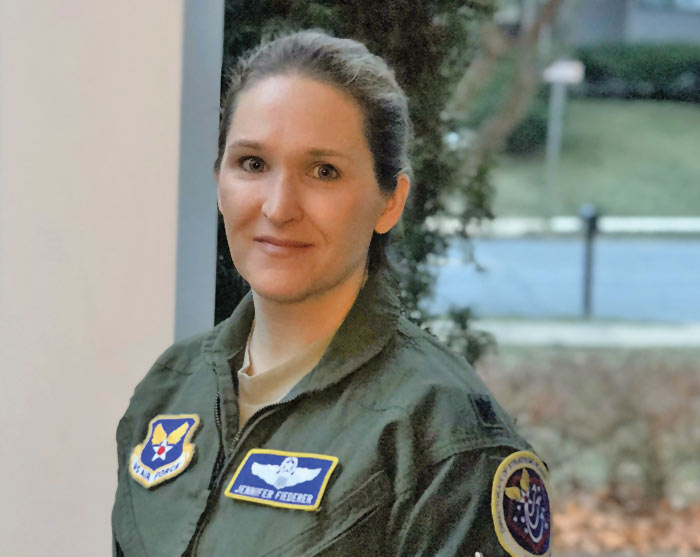Delta Pilot Assesses Pilot Supply Concerns
By John Perkinson, Senior Staff Writer

F/O Jennifer Fiederer (Delta)
Attracting and retaining future pilots isn’t just a concern for ALPA and the airline industry. The U.S. Air Force is also looking at ways it can better meet pilot staffing needs to fulfill its mission directives. Just ask F/O Jennifer Fiederer (Delta), a lieutenant colonel and citizen airman in the Air Force Reserve on leave from her airline. Among her various military responsibilities, Fiederer is a member of the Aircrew Crisis Task Force working at the Pentagon to study the current pilot deficit in her branch of the service.
“When I first came to the Pentagon a few years ago, I worked with the Total Force Continuum Office,” said Fiederer, noting that she and her coworkers built a model for data analysis to compare pilot training production numbers to the organization’s actual staffing needs. She soon transitioned to the Aircrew Crisis group.
“My team specifically looks at the issue of inclusiveness,” Fiederer acknowledged, adding that the group is considering ways to encourage diversity and remove possible impediments to serving long term as an Air Force pilot.
“At a time when females are graduating from college at a higher rate than males and many are entering the military, we want to know why female Air Force pilot training numbers are stagnant,” she said. “We also want to know why the female pilot retention rate is so low. A larger percentage of female pilots leaves the Air Force early as compared to males.” Fiederer noted that her group is approaching this analysis from a variety of angles, from attitudes toward the service’s maternity-leave policy to concerns like whether current cockpit designs have unintended biases.
An Air Force Magazine article from February 2018 titled “Growing Pains: Something’s Gotta Give,” observed, “In recent years budget constraints have pushed the Air Force to make a priority of capability over capacity, leading to a drastic reduction in the service’s personnel end strength.” In addition, for reasons the Aircrew Crisis Task Force is exploring, some Air Force pilots have felt compelled to pursue other job opportunities, including flying for the airlines, in recent years.
“The inclusiveness effort is still relatively new,” commented Fiederer, who added that among the Air Force’s various initiatives, it’s launched a collaborative effort with the civilian aviation industry, through its National Pilot Sourcing Forum. The military and airlines are discussing ways to raise interest in flying for a living and to better channel future pilot candidates to job openings. Fiederer also contacted ALPA, after being encouraged as a female member to participate in the Association’s Women’s Working Group survey.
The Air Force’s Air Education and Training Command, whose mission is to “recruit, train, and educate airmen to deliver air power for America,” reports that it’s currently on track to meet its goal of 325,000 active-duty airmen in FY 2018. However, Air Force cockpits were understaffed last year by nearly 2,000, and the Aircrew Crisis Task Force will play an important role in helping to ensure that the service’s future pilot goals are met.
Among her other responsibilities, Fiederer prepares budgets for Rapid Global Mobility, which provides national leaders with the ability to “project hard and soft power at any time, to any location on the globe.”
Fiederer brings her own special insight to the Aircrew Crisis Task Force’s inclusiveness line, adding, “I’m a historical data point on why females leave.” She joined the service in 1998 and for many years flew as a Boeing KC-135 Stratotanker pilot. Fiederer left active duty, transitioning to part-time reserve status in 2009 and eventually went to work for Delta in 2014, where she is an A320 pilot based in Salt Lake City, Utah.
However, she returned full time to the Air Force Reserve in 2016 to take on her current projects. The lieutenant colonel hopes to resume flying for Delta this August, while converting back to part-time reserve duty. Through her personal experience, Fiederer may just be demonstrating to the service and her airline that it’s possible to enjoy the best of both worlds.

